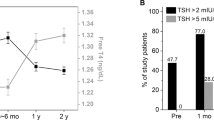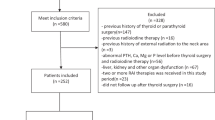Abstract
Papillary thyroid carcinoma (PTC) is a common thyroid malignancy. Elderly patients have more severe disease and more complications following postoperative endocrine therapy to control thyroid-stimulating hormone (TSH) levels. We aimed to identify optimal postoperative serum TSH levels in elderly patients to prevent recurrence and metastasis and minimize complications. This retrospective cohort study collected data of 87 consecutive elderly patients (age >75) who underwent surgery for PTC with postoperative levothyroxine therapy (50–150 μg/d) between January 2006 and June 2008 and were followed until 2013. After 24 patients with TSH fluctuations and incomplete data were excluded, 73 patients were grouped based on postoperative TSH levels: Group A, 0.3–0.5 mIU/mL; Group B, 0.1–0.3 mIU/mL; and Group C <0.1 mIU/mL (n = 24, 25, 24, respectively). Subjects’ baseline, preoperative data, postoperative complications and 1-, 3- and 5-year follow-up data were compared between groups. No significant differences in gender, age (median age of 80 years old), surgery type or clinical characteristics were found between groups (all p value >0.05). Postoperatively, all subjects had normal ECG and neck ultrasound, no osteoporosis, and no differences in survival rate or metastasis. Five-year follow-up revealed significant differences in development of arrhythmias, osteoporosis, insomnia and anxiety between Groups B (0.1–0.3 mIU/mL) and C (<0.1 mIU/mL) compared to Group A (0.3–0.5 mIU/mL). Postoperative incidence of PTC recurrence and metastasis remained stable in elderly patients undergoing thyroid surgery and endocrine therapy but complications increased significantly with increasing TSH levels. Controlling TSH to lower limits of normal may help prevent PTC recurrence and metastasis and reduce complications in this high-risk population.
Similar content being viewed by others
References
Samadi A, Loo P, Mukerji R, O’Donnell G, Tong X, Timmermann BN, Cohen MS (2009) A novel HSP90 modulator with selective activity against thyroid cancers in vitro. Surgery 146:1196–1207
Hodgson NC, Button J, Solorzano CC (2004) Thyroid cancer: is the incidence still increasing? Ann Surg Oncol 11:1093–1097
Pacini F, Castagna MG, Brilli L, Pentheroudakis G, ESMO Guidelines Working Group (2009) Differentiated thyroid cancer: ESMO clinical recommendations for diagnosis, treatment and follow-up. Ann Oncol 20(Suppl 4):143–146
Pacini F, Schlumberger M, Dralle H, Elisei R, Smit JW, Wiersinga W, Taskforce European Thyroid Cancer (2006) European consensus for the management of patients with differentiated thyroid carcinoma of the follicular epithelium. Eur J Endocrinol 154:787–803
Pelizzo MR, Merante Boschin I, Toniato A, Pagetta C, Casal Ide E, Mian C, Rubello D (2008) Diagnosis, treatment, prognostic factors and long-term outcome in papillary thyroid carcinoma. Endocrinol 33:359–379
Uruno T, Miyauchi A, Shimizu K, Tomoda C, Takamura Y, Ito Y, Miya A, Kobayashi K, Matsuzuka F, Amino N, Kuma K (2009) Favorable surgical results in 433 elderly patients with papillary thyroid cancer. Word J Surg 29:1497–1501
Burns WR, Zeiger MA (2010) Differentiated thyroid cancer. Semin Oncol 37:557–566
Jonklaas J, Sarlis NJ, Litofsky D, Ain KB, Bigos ST, Brierley JD, Cooper DS, Haugen BR, Ladenson PW, Magner J, Robbins J, Ross DS, Skarulis M, Maxon HR, Sherman SI (2006) Outcomes of patients with differentiated thyroid carcinoma following initial therapy. Thyroid 16:1229–1242
American Thyroid Association (ATA) Guidelines Taskforce on Thyroid Nodules and Differentiated Thyroid Cancer, Cooper DS, Doherty GM, Haugen BR, Kloos RT, Lee SL, Mandel SJ, Mazzaferri EL, McIver B, Pacini F, Schlumberger M, Sherman SI, Steward DL, Tuttle RM (2009) Revised American Thyroid Association Management Guidelines for Patients with Thyroid Nodules and Differentiated Thyroid Cancer. Thyroid 19:1167–1214
NCCN Clinical Practice Guidelines in Oncology (2012) Thyroid carcinoma (S/OL).Version1.2012. http://www.nccn.org/professionals/physician.gls/pdf/thyroid.pdf
Chew MH, Chan G, Siddiqui MM, Tai BC, Sivanandan R, Soo KC, Lim DT (2008) Risk-stratified management of well-differentiated thyroid cancers: a review of experience from a single institution, 1990–2003. World J Surg 32:386–394
Ito Y, Higashiyama T, Takamura Y, Miya A, Kobayashi K, Matsuzuka F, Kuma K, Miyauchi A (2007) Risk factors for recurrence to the lymph node in papillary thyroid carcinoma patients without preoperatively detectable lateral node metastasis: validity of prophylactic modified radical neck dissection. World J Surg 31:2085–2091
Kim KW, Park YJ, Kim EH, Park SY, Park do J, Ahn SH, Park do J, Jang HC, Cho BY (2011) Elevated risk of papillary thyroid cancer in Korean patients with Hashimoto’s thyroiditis. Head Neck 33:691–695
Sawin CT, Geller A, Wolf PA, Belanger AJ, Baker E, Bacharach P, Wilson PW, Benjamin EJ, D’Agostino RB (1994) Low serum thyrotropin concentrations as a risk factor for atrial fibrillation in older persons. N Engl J Med 33:1249–1252
Toft AD (2001) Clinical practice. Subclinical hyperthyroidism. N Engl J Med 345:512–516
Marcocci C, Golia F, Bruno-Bossio G, Vignali E, Pinchera A (1994) Carefully monitored levothyroxine suppressive therapy is not associated with bone loss in premenopausal women. J Clin Endocrinol Metab 78:818–823
Jódar E, Begoña López M, García L, Rigopoulou D, Martínez G, Hawkins F (1998) Bone changes in pre- and postmenopausal women with thyroid cancer on levothyroxine therapy: evolution of axial and appendicular bone mass. Osteoporos Int 8:311–316
Horne MK 3rd, Singh KK, Rosenfeld KG, Wesley R, Skarulis MC, Merryman PK, Cullinane A, Costello R, Patterson A, Eggerman T, Bernstein DM, Pucino F, Csako G (2004) Is thyroid hormone suppression therapy prothrombotic? J Clin Endrinol Metab 89:4469–4473
Biondi B, Filetti S, Schlumberger M (2005) Thyroid-hormone therapy and thyroid cancer: a reassessment. Nature Clin Pract Endocrinol Metab 1:32–40
Acknowledgments
The study was funded by Health Department project of Zhejiang Province (No. 201234615).
Conflict of interest
None.
Author information
Authors and Affiliations
Corresponding author
Additional information
Q. Xia and S. Dong are contributed equally to this work.
Rights and permissions
About this article
Cite this article
Xia, Q., Dong, S., Bian, PD. et al. Effects of endocrine therapy on the prognosis of elderly patients after surgery for papillary thyroid carcinoma. Eur Arch Otorhinolaryngol 273, 1037–1043 (2016). https://doi.org/10.1007/s00405-015-3564-2
Received:
Accepted:
Published:
Issue Date:
DOI: https://doi.org/10.1007/s00405-015-3564-2




